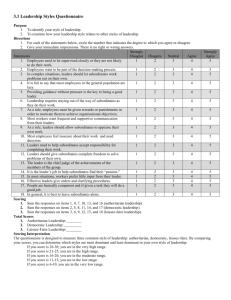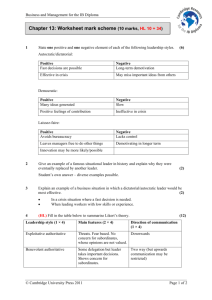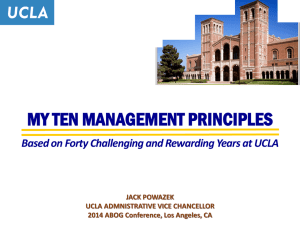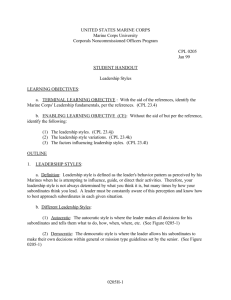Management Styles and Commitment: A Cross-Cultural Study
advertisement
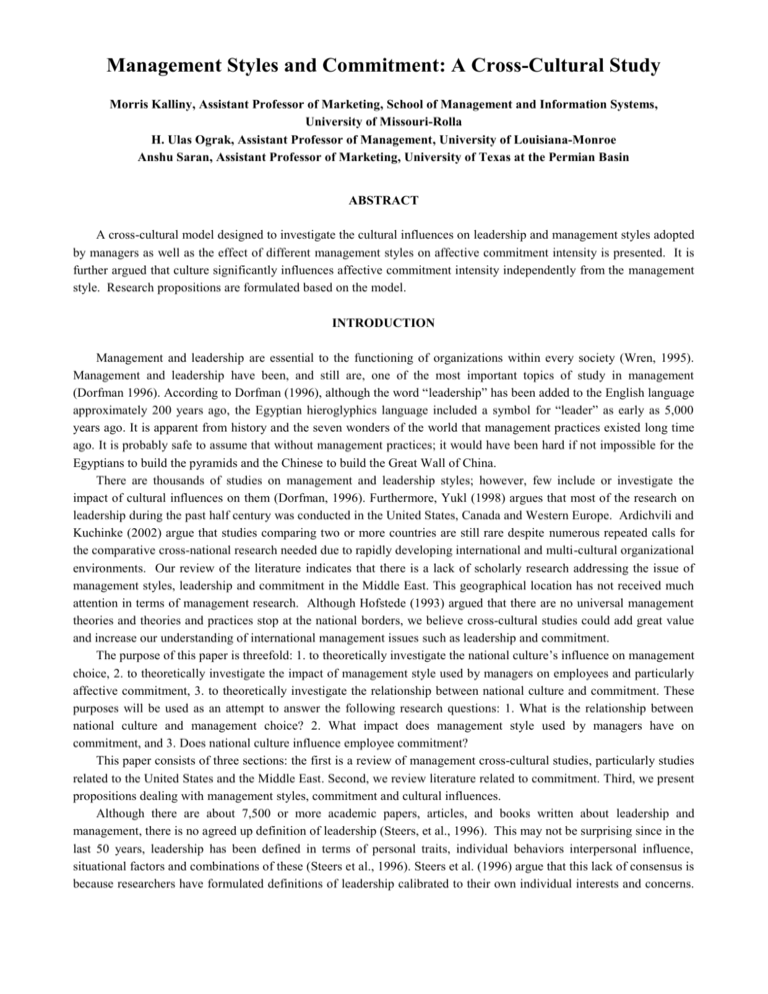
Management Styles and Commitment: A Cross-Cultural Study Morris Kalliny, Assistant Professor of Marketing, School of Management and Information Systems, University of Missouri-Rolla H. Ulas Ograk, Assistant Professor of Management, University of Louisiana-Monroe Anshu Saran, Assistant Professor of Marketing, University of Texas at the Permian Basin ABSTRACT A cross-cultural model designed to investigate the cultural influences on leadership and management styles adopted by managers as well as the effect of different management styles on affective commitment intensity is presented. It is further argued that culture significantly influences affective commitment intensity independently from the management style. Research propositions are formulated based on the model. INTRODUCTION Management and leadership are essential to the functioning of organizations within every society (Wren, 1995). Management and leadership have been, and still are, one of the most important topics of study in management (Dorfman 1996). According to Dorfman (1996), although the word “leadership” has been added to the English language approximately 200 years ago, the Egyptian hieroglyphics language included a symbol for “leader” as early as 5,000 years ago. It is apparent from history and the seven wonders of the world that management practices existed long time ago. It is probably safe to assume that without management practices; it would have been hard if not impossible for the Egyptians to build the pyramids and the Chinese to build the Great Wall of China. There are thousands of studies on management and leadership styles; however, few include or investigate the impact of cultural influences on them (Dorfman, 1996). Furthermore, Yukl (1998) argues that most of the research on leadership during the past half century was conducted in the United States, Canada and Western Europe. Ardichvili and Kuchinke (2002) argue that studies comparing two or more countries are still rare despite numerous repeated calls for the comparative cross-national research needed due to rapidly developing international and multi-cultural organizational environments. Our review of the literature indicates that there is a lack of scholarly research addressing the issue of management styles, leadership and commitment in the Middle East. This geographical location has not received much attention in terms of management research. Although Hofstede (1993) argued that there are no universal management theories and theories and practices stop at the national borders, we believe cross-cultural studies could add great value and increase our understanding of international management issues such as leadership and commitment. The purpose of this paper is threefold: 1. to theoretically investigate the national culture‟s influence on management choice, 2. to theoretically investigate the impact of management style used by managers on employees and particularly affective commitment, 3. to theoretically investigate the relationship between national culture and commitment. These purposes will be used as an attempt to answer the following research questions: 1. What is the relationship between national culture and management choice? 2. What impact does management style used by managers have on commitment, and 3. Does national culture influence employee commitment? This paper consists of three sections: the first is a review of management cross-cultural studies, particularly studies related to the United States and the Middle East. Second, we review literature related to commitment. Third, we present propositions dealing with management styles, commitment and cultural influences. Although there are about 7,500 or more academic papers, articles, and books written about leadership and management, there is no agreed up definition of leadership (Steers, et al., 1996). This may not be surprising since in the last 50 years, leadership has been defined in terms of personal traits, individual behaviors interpersonal influence, situational factors and combinations of these (Steers et al., 1996). Steers et al. (1996) argue that this lack of consensus is because researchers have formulated definitions of leadership calibrated to their own individual interests and concerns. However, management scholars realize the importance of investigating leadership from a broader perspective. For example, GLOBE research project is organized to investigate leadership not only in the United States but also in many other cultures. For the purpose of this study, a leader is someone who influences others to do something. We chose this definition for two reasons: first, this is a cross-cultural study and according to Dorfman (1996), no definitive answer has been provided as to whether leadership should be defined and conceptualized differently across cultures and second, most other definitions are qualified and limit the concept of leadership. MANAGEMENT (LEADERSHIP) STYLES The first part of this paper focuses on the management styles and the impact of culture on choice of management styles and management practices. In 1980, McBer and Company developed six managerial styles that we use as management styles. The following is a brief description of each management style: Coercive McBer and Company (1980) describe this style as "do it the way I tell you". This coercive style tend to provide clear direction by telling subordinates what to do, without listening to or allowing for much subordinate input. Manager/leaders expect immediate subordinate compliance and obedience. They like to maintain tight control, often by requiring many detailed reports. They give more negative and "personalized" feedback and motivate by threats of discipline or punishment. Authoritative McBer and Company (1980) describe this style by "firm but fair". Authoritative managers/leaders tend to provide direction, tactfully, but without leaving any doubt as to what is expected or who has the authority and makes the final decisions. They may solicit some subordinate input. They persuade subordinates by explaining the "whys" behind directions or decisions, in terms of either the subordinate's or the organization's best interest. Authoritative managers monitor task performance and balance positive and negative feedback. McNamara (2003) describes this authoritative management style as the autocratic. He states that the autocratic leader dominates team-members and uses unilateralism to achieve a singular objective. He argues that this management style generally results in passive resistance from team-members and may require a continuous pressure and direction from the leader. Affiliative McBer and Company (1980) describe this style by "people first, task second". Affiliative managers/leaders tend to consider concern for subordinates and personal popularity the most important aspect of the manager's job. They provide no clear direction, goals, or standards. They provide job security, fringe benefits, and office amenities to keep subordinates happy, and avoid conflicts that might cause "hard feelings." Democratic McBer and Company (1980) describe this style as "participative,” Democratic managers/leaders tend to consider specific direction and close supervision unnecessary when trust has been established. They believe subordinates‟ participation in decisions that affect their work should be encouraged and making decisions by consensus should be thought after. They reward adequate performance and rarely punish or give negative feedback. They hold many meetings, listen to subordinates, and find out what they have to say. McNamara (2003), states that the democratic leader makes decision by consulting his team whilst maintaining control of the group. The leader allows the team to decide how the task will be tackled. McNamara believes that a good democratic leader encourages participation and delegates wisely. Democratic leaders motivate by empowering the team members. McNamara warns that the democratic leader can be seen as being unsure of himself and that could have a detrimental effect on management effectiveness. Pace-setting McBer and Company (1980) describe this style as "do it myself." Pace-setting managers/leaders tend to have high standards, expect self-direction from themselves and others, and lead by example or "modeling." They do not like to delegate because they believe they can do most jobs better than their subordinates. They generally take responsibility for tasks away from subordinates and do the task themselves and/or become coercive when subordinates experience difficulties. They have little sympathy for poor performance; hence, they do not develop subordinates. Coaching McBer and Company (1980) describe this style by "developmental". Coaching managers/leaders tend to be concerned with high performance standards but do not make these expectations clear to subordinates. They see their job as helping or demonstrating to subordinates how to improve their performance and encouraging their professional development. They direct by asking subordinates to set their own goals, develop plans, and identify solutions to problems, rather than setting specific goals for performance criteria or telling subordinates what to do. MANAGEMENT STYLES, CULTURE AND RELIGION There have been a numerous studies advocating the general notion that culture has an influence on management and management styles (Hartog, et al. 1999; Ardichvili & Kurchinke 2002; Smith, et al. 1989). However, there are few studies that investigated the relationship between culture and management styles in the Middle East. Several scholars (Child & Keiser 1979; Maurice, 1979; Redding et al., 1994) argued that specific cultural traditions, values, ideologies, and norms are bound to differentiate between societies, and historical developments influence the evolution of distinctive phenomena such as degree of cooperation morale and commitment to organizations. Based on this premise we introduce a historical background that might assist in understanding the management styles usually exhibited in the Muslim world like Egypt and Turkey. An interesting question is why in some countries the autocratic management/leadership is more prevalent than in other countries? Dickson (2000) argues that studying the historical background of nations can help in increasing our understanding of behaviors. We focus on culture and religion and use Hofstede‟s cultural dimensions as a theoretical foundation for our propositions. Kabasakal and Bodur (2002, p. 47) stated, “The verses in the Holy Koran also reflect inequalities in power distribution. Islam clearly advocates that people accept the authority of people in leadership positions. It is stressed that people should not be critical of decisions and application of their superiors and obey them without any questions. This phenomenon of power distribution has been investigated by Hofstede who calculated a power distance score for each country. Most of the Middle East (Arab) countries were found to score very highly on this dimension. Power distance is, “the extent to which less powerful members of institutions and organizations within a country expect and accept that power is distributed unevenly” (Hofstede, 1984, p.98). Power distance dimension focuses on the degree of equality, or inequality, between people within the same society. A high power distance ranking indicates that inequalities of power and wealth are allowed to grow within a society. A low power distance ranking indicates that society de-emphasizes the differences between citizen's power and wealth. In these societies, equality and opportunity for everyone are stressed. High power distance index can be found to have the following traits: superiors consider subordinates to be of a different kind and visa-versa, power holders are entitled to privileges and, subordinate-superior relations are polarized (Hofstede, 1984). Hofstede argues that individuals from high power distance cultures tend to be less questioning of authority. Moaddel (2002), argue that the relationship between Islamic culture and authoritarianism is established through the legitimizing power of such a patriarchal conception of leadership as za’im (leader) and za’ama (leadership). Once a leader emerges, he is given honor, freedom and power. Lapidus (1992) on the other hand argues that modern authoritarianism in the Islamic culture is rooted in the second golden age of historical Islam highlighted by the rise of Islamic empires. Lapidus (1992 p.23) argues that this historical authoritarianism has continued into the modern period as, for example, “as many features of Turkish republic and the Ataturk program may be derived from the patrimonial premises of the Ottoman empire.” On the other hand, we have the United States that scored only 40 on Hofstede‟s dimension of power distance. This is not surprising either because there are some cultural influences that contributed to this. For example, the United States is based on the protestant ethic that emphasizes equality between people. The idea of absolute or even too much power for leaders or superiors in the American culture is discouraged. Ali (1990) argues that current leadership and management thinking and practices in the Middle East continue to be influenced by various Islamic schools of thought. Thus, Proposition 1: The autocratic leadership and management style will be more prevalent in the Muslim countries compared to the United States due to Islamic teachings and values. Proposition 2: The autocratic leadership and management style will be more acceptable by the Middle Eastern (Arab) employees compared to U.S. employees because of the high power distance and the teachings of Islam regarding authority. Proposition 3: The democratic leadership and management style will be more prevalent in the United States compared to the Middle East (Arab countries). The Koran attests, “O ye who believe! Obey Allah and obey the Messenger, and those charged with authority among you.” (Surat An-Nisa, section 5 (59) Holy Koran). This verse indicates that Islam stresses that subordinates are to obey their leaders and do what they ask. This religious requirement provides leaders with tremendous amount of power and control over subordinates, which they could use in many different ways. It is probably plausible to assume that since this obedience is a religious requirement, leaders are given much freedom to choose how to deal with subordinates who do not show obedience and compliance. In this study, we argue that Arab leaders and managers may choose force or coercion to get their subordinates to follow since subordinates‟ obedience is a religious requirement. Several studies (Fontaine & Beerman, 1977; Ivancevich & Donnelly, 1970; Patchen, 1974; Speckman, 1979) investigated how subordinates in the United States perceive the use of coercive power by leaders. The consensus among these studies is that subordinates in the United States perceive the coercive power base as a weak reason for compliance with a superior‟s or a leader‟s wishes. These studies show that the use of coercive power is not a very effective tool of management in the United States. Thus: Proposition 4: The coercive management style will be more prevalent in Arab countries compared to the United States. Proposition 5: The coercive management style will be more acceptable in Arab countries compared to the United States. Proposition 6: The coaching management style will be more prevalent in the United States compared to Arab countries. COMMITMENT A part of job-related attitudes along with job satisfaction and job involvement, organizational commitment has attracted a vast amount of attention from organizational scientists (Allen and Meyer, 1990; Mathieu and Zajac, 1990; Morrow, 1993; Mowday, Porter, and Steers, 1982; Riketta and Landerer, 2002; Steers, Porter, and Bigley, 1996). The vast attention to the topic also indicates a large number of attempts to define the construct; therefore little consensus exists among the definitions (Mowday, Porter, and Steers, 1982). Despite the little consensus among the various definitions, there is a common point that organizational commitment is considered a “bond or liking of the individual to the organization” (Mathieu and Zajac, 1990, pp. 171). Defined simply as “a form of extreme loyalty to one‟s organization” (Pinder, 1998, pp. 263), organizational commitment differs from job satisfaction and job involvement as it involves the individual worker‟s attitude toward the organization, and not his/her job, department, work group, occupation, or career (Pinder, 1998). O‟Reilly and Chatman (1986) divide organizational commitment to three distinct psychological stages (processes): Compliance, identification, and internalization. Compliance means that the person recognizes influence of others because he/she is expecting to obtain something tangible from others, whereas influence suggests that the person accepts influence in order to “maintain a satisfying, self-defining relationship” (Steers et. al., 1996; pp. 374). Finally, the individual internalizes, that is, he/she finds the values of the organization to be congruent with his/her personal values. This categorization is similar to continuance commitment, normative commitment, and affective commitment respectively (Meyer, and Allen, 1991, 1997; Morrow, 1993), three interrelated dimensions of the construct. Continuance commitment involves a tangible outcome that the individual does not want to let go, normative commitment includes a moral aspect, and affective commitment comprises a voluntary facet stronger than any other factor on the individual‟s part to continue employment with the organization. Although the three dimensions should be considered as components rather than different types of commitment (Pinder, 1998), this paper focuses on affective commitment, as it entails internalization beyond identification, the closest association between the individual‟s own motives and the motives of the organization (Pinder, 1998). Why is commitment important? According to Pinder (1998), there is a belief among employers that highly committed employees perform better and are less likely to be absent. Although the evidence does not support most of the employer‟s beliefs and expectations about organizational commitment such as committed employee performs better (Mathieu and Zajac, 1990), affective commitment was found to be the best predictor of withdrawal in a study conducted by Somers in 1995 (Pinder, 1998). Furthermore, according to Mowday et al (1982), the strongest behavioral outcome of commitment should be reduced employee turnover, and the studies they examined corroborate their proposition. Organizational commitment has many hypothesized antecedents such as personal characteristics, work experiences, and organizational (structural) characteristics (Meyer and Allen, 1997; Mowday, et. al, 1982). This paper focuses on the effect of management style and the effect of national culture independent from the management style on affective commitment. The authors propose that culture will affect the management style adopted by managers, which, in turn, affects organizational commitment. In addition, culture is expected to directly affect commitment. The lack of research pertaining to leadership and management style and culture as antecedents of organizational commitment underlines the value of this study. CULTURE AND COMMITMENT Culture has many definitions (Adler, 2002; Hofstede, 1980). According to Adler (2002), one of the most comprehensive and generally accepted definitions is Kroeber and Kluckhohn‟s definition: “Culture consists of patterns, explicit and implicit, of and for behavior acquired and transmitted by symbols, constituting the distinctive achievement of human groups, including their embodiment in artifacts; the essential core of culture consists of traditional (i.e. historically derived and selected) ideas and especially their attached values; culture systems may, on the one hand, be considered as products of action, on the other, as conditioning elements of future action.” (Kroeber and Kluckhohn, 1952 in Adler, 2002). Hofstede (1980, p. 25) defines culture as “the collective programming of the mind which distinguishes the members of one group from another…the interactive aggregate of common characteristics that influence a human group‟s response to its environment.” According to Adler (2002), people are seen as being from different cultures if their ways of life as a group differ significantly. Hofstede (1980) states that “culture is to a human collectivity what personality is to an individual” (p.25), in other words, culture determines the group just as personality determines the individual. Culture finds expression through values, and determines behavior through attitudes and behavior, which, in turn affect culture (Adler, 2002). This relationship is depicted in figure 1. Figure 1. Influence of culture on behavior and behavior on culture Source: Adler, 2002, pp. 17 To the best of our knowledge, the effect of culture on commitment has not been investigated. Therefore, departing from the above-depicted relationship, we propose that culture is a significant factor that effects commitment, since commitment is a job-related attitude. Furthermore, we argue that the intensity of commitment will vary across cultures. Adopting Hofstede‟s (1980) classification, we posit that culture has a stronger influence on commitment intensity in high power-distance cultures as opposed to low power-distance cultures (Arab countries versus USA in this study). Moreover, we propose that culture will have a stronger effect on commitment intensity in Arab countries that have a lower score on masculinity scale as opposed to USA. Thus: Proposition 7a: Culture has a significant effect on the commitment intensity. Proposition 7b: The effect of culture on commitment intensity will be greater in high power-distance cultures as opposed to low-power distance cultures. Proposition 7c: The effect of culture on commitment intensity will be greater in countries that have a lower masculinity score as opposed to countries that have a higher masculinity score. CONCLUSION The terrorist attacks on the World Trade Center five years ago and the events such as the Iraqi War that ensued not only widened the cultural gap between the East and the West and polarized civilizations, they also told us something: Understanding culture(s) is ever more important in these days of turmoil and distrust. Culture may be the key to understand the fanatic commitment of the terrorists to their cause, whatever it may be. It is not only appalling but also dazzling to see human beings so committed to a cause that they are prepared to end not only their lives but thousands of innocent civilians‟ lives with them without hesitation. Barnard‟s Acceptance Theory of Authority (1938) suggests that individuals do, indeed question authority and that the motive underlying cooperative action is determined by the perceived self incentives associated with it, in comparison with other available incentives coupled with other possible cooperative actions. It is apparent that the Acceptance Theory of Authority and all related scholarly work that followed were developed for the West, mainly the U.S. There is a need for scholarly attention in studies that emphasize cultural differences. In this paper, we posit that culture will be effective in the managerial style adopted, and culture and managerial style will determine commitment intensity. Furthermore, it is expected that autocratic and coercive management styles will be more readily chosen and more widely accepted in Muslim countries as opposed to U.S., where the democratic and coaching management styles are more prevalent. This study aims to explore the interrelationships between culture, commitment and management. Such studies should help reduce the culture gap between Western civilizations and the Arab world. Practitioners, especially MNEs with investments in the Middle East will also benefit from the results of this study, as it increases their understanding of their workforce. REFERENCES Adler, N. (2002). International dimensions of organizational behavior. Cincinnati, OH: South-Western. Al-Faleh, M. (1986). Cultural influences on Arab management development: A case study of Jordan. Arab Management Review, 6, 19-33. Ali, Abbas (1990), “Management Theory in a Transitional Society: the Arab‟s Experience,” International Studies of Management and Organization, Vol. 20 (3), 7-35. Allen, N. J., & Meyer, J. P. (1990). The Measurement and Antecedents of Affective, Continuance and Normative Commitment to the Organization. Journal of Occupational Psychology, 63, 1-18. Ardivhvili, A., & Kuchinke, P. (2002). Management styles and cultural values among managers and subordinates: A comparative study of four countries of the former Soviet Union, Germany, and The US. Human Resource Development International 5(1), 99-117. Barnard, C. I. 1938. The Functions of the Executive. Cambridge, MA: Harvard University Press. Carter McNamara (2003), “Overview of Management in Organizations,” (accessed September 15, 2003), [available at: http://www.mapnp.org/library/ldrship/ldrship.htm#anchor283260]. Child J. D., and Keiser D. J. (1979), “Organizational and Managerial Roles in British and West German Companies: An Examination of the CultureFree Thesis. In C. J. Lammers, and D. J. Hickson (Eds.), Organizations Alike and Unlike: International and Interinstitutional Studies in the Sociology of Organizations (pp. 251-271). London: Routledge and Kegan Paul. Dorfman P. W. (1996). International and cross-cultural management, p. 276-331. Dickson, P. (2000). Understanding the trade winds: The global evolution of production, consumption, and the internet. Journal of Consumer Research, 27(1), 115-122. Fontaine, G., and Beerman, J. (1977), “Affective Consequences of Social Power: Power holder and Target Expectancies Associated with Different Types of Power,” Psychological Reports, 40, 771-774. Hartog, D., Deanne N., House, R., Hanges, P., Ruiz Q., & Dorfman P. (1999). Culture specific and cross-culturally generalizable implicit management theories: Are attributes of charismatic/transformational management universally endorsed. Management Quarterly 10(2), 219-256. Hofstede, G. (1984). Culture‟s Consequences: International Differences in Work-Related Values, Newbury Park, CA, SAGE Publications. Hofstede, G. (1980). Culture’s consequences: International differences in work-related values. Beverly Hills, CA: Sage Publications. Ivancevich J. M., and Donnelly, J. H. (1979), “Leader Influence and Performance,” Personnel Psychology, 23, 539-549. Kabasakal, H., & Bodur, M. (2002). Arabic cluster: A bridge between East and West. Journal of World Business 37, 40-54. Lapidus IM. (1992). The Golden Age: the political concepts of Islam. Annual American Academy of political and Sociology Science (November), 13-25. Mathieu, J. E., & Zajac, D. M. (1990). A review and meta-analysis of the antecedents, correlates, and consequences of organizational commitment. Psychological Bulletin, 108(2), 171-195. McBer and Company. Trainer‟s Guide. Boston: McBer and Company, 1980. Meyer, J. P., & Allen, N. J. (1991). A three-component conceptualization of organizational commitment. Human Resource Management Review, 1, 61-89. Meyer, J. P., & Allen, N. J. (1997). Commitment in the workplace: Theory, research, and application. Thousand Oaks, CA: Sage Publications, Inc. Moaddel, Mansoor (2002). The Study of Islamic Culture and Politics: An Overview and Assessment. Annual Review of Sociology (28), 359-86. Maurice, M. (1979), “For a Study of the „Social Effect‟: Universality and Specificity in Organizational Research. In C. J. Lammers, and D. J. Hickson (Eds.), Organizations Alike and Unlike: International and Interinstitutional Studies in the Sociology of Organizations (pp. 42-60). London: Routledge and Kegan Paul. Morrow, P. C. (1993). Theory and measurement of work commitment. Jai Press, Inc. Mowday, R. T., Porter, L. W., & Steers, R. M. (1982). Employee-organization linkages: The psychology of commitment, absenteeism, and turnover. New York, NY: Academic Press, Inc. Mowday, R. T., Steers, R. M. & Porter, L. W. (1979). The measurement of organizational commitment. Journal of Vocational Behavior, 14, 224247. O‟Reilly, C., & Chatman, J. (1986). Organizational commitment and psychological attachment: The effects of compliance, identification, and internalization on prosocial behavior. Journal of Applied Psychology, 71, 492-499. Patchen, M. (1974), “The Locus and Basis of Influence on Organizational Decisions,” Organizational Behavior and Human Performance, 11, 195-221. Pinder, C. (1998). Work motivation in organizational behavior. Prentice Hall. Riketta, M., & Landerer, A. (2002). Organizational commitment, accountability, and work behavior: A correlational study. Social Behavior and Personality, 30(7), 653-660. Redding S. G., Norman, W. T., and Schlander, S. (1994), “Individual Attachment to the Organization,” In H. C. Triandis, M. D. Dunette, and L. H. Hough (Eds.), Handbook of Industrial and Organizational Psychology (Vol. 4, pp. 648-688). Palo Alto: Consulting Psychology Press. Sharda, B. D., & Miller, G. (2001). Culture and organizational structure in the Middle East: A comparative analysis of Iran, Jordan and USA. International Review of Sociology, 11 (3), 309-325. Smith, P., Misumi, J., Tayeb, M., Peterson, M., & Bond, M. (1989). On the generality of management style measures across cultures”, Journal of Occupational Psychology, 62, 97-109. Speckman, R. E. (1979), “Influence and Information: An Exploratory Investigation of the Boundary role Person‟s Basis of Power,” Academy of Management Journal, 22, 104-117. Steers, R. M., Porter, L. M., & Bigley, G. A. (1996) Motivation and management at work. Boston, MA: McGraw-Hill. Wren, T. J. (Ed). (1995). The leader’s companion: Insights on management through the ages. New York, NY: Free Press Yukl, G. (1998). Management in organizations. Englewood Cliffs, NJ: Prentice-Hall.
